The Indigenous Koho People
Ethnonyms: Coho, Co-ho, Ko-ho, Kohor, K'ho Countries inhabited: Vietnam, USA Language family: Austroasiatic Language branch: Mon-Khmer
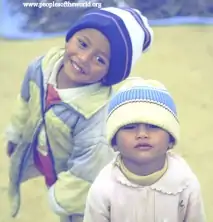
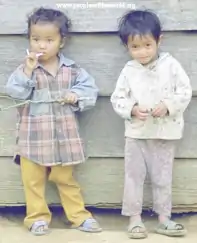 The Koho are among the poorest of Vietnam's indigenous minority peoples. Traditionally
slash-and burn farmers,
they settled in the southern part of the fertile Central Highlands area of Vietnam centuries ago, mainly in the area around
what is now the modern city of Dalat — a former French colonial outpost. Indeed, Chicken Village, just outside Dalat, is
probably the best-known, most easily accessed and most-touristed place in all of Vietnam to visit the Koho.
(None of these pictures were taken there.)
The Koho are among the poorest of Vietnam's indigenous minority peoples. Traditionally
slash-and burn farmers,
they settled in the southern part of the fertile Central Highlands area of Vietnam centuries ago, mainly in the area around
what is now the modern city of Dalat — a former French colonial outpost. Indeed, Chicken Village, just outside Dalat, is
probably the best-known, most easily accessed and most-touristed place in all of Vietnam to visit the Koho.
(None of these pictures were taken there.)
Today there are around one hundred thousand Koho in Vietnam's Central Highlands — around 10% of the indigenous population in the area. At home, they still mainly speak their indigenous language, despite their children now being schooled exclusively in Vietnamese. However, other forms of past Koho tradition, such as their clothing and stilted, bamboo-walled longhouses, are much harder to find these days. Also disappearing slowly is their Animist belief system and ritual practice: This part of Vietnam was missionized around a hundred years ago by some of the earliest Christian missionaries to visit Vietnam.
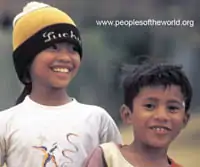
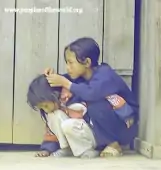 It was Christian missionaries who first transliterated the Koho language
using a form of the Roman alphabet — although parts of the Bible first appeared in the Koho language
using this alphabet only in 1950.
The whole Bible has still not been fully translated.
Despite
this missionization, however, the
visitor may still find signs of Koho religious tradition in some villages.
For example, animal (particularly buffalo)
sacrifice is still performed as ritual offering to the spirits. Also, ancestral worship altars
(ornately carved wooden boards called co nao) are still quite common in Koho houses.
It was Christian missionaries who first transliterated the Koho language
using a form of the Roman alphabet — although parts of the Bible first appeared in the Koho language
using this alphabet only in 1950.
The whole Bible has still not been fully translated.
Despite
this missionization, however, the
visitor may still find signs of Koho religious tradition in some villages.
For example, animal (particularly buffalo)
sacrifice is still performed as ritual offering to the spirits. Also, ancestral worship altars
(ornately carved wooden boards called co nao) are still quite common in Koho houses.
The Koho have been recognized in the west — indeed honored in the United States, along with many other ethnolinguistic minority groups from the Central Highlands of Vietnam, such as the Jarai, Ede, Bahnar, Stieng, and Mnong, for the role they played fighting alongside American soldiers in the American war in Vietnam. This earned these groups the nickname "America's forgotten army" in the US — a more benevolent term than that by which they were known to the South Vietnamese, moi, meaning savages.
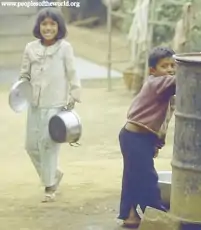
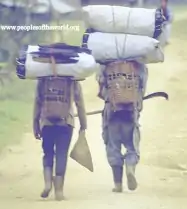 For that role, like many other groups in this area of Vietnam,
they were persecuted after Vietnam's 1975 reunification. Recent persecution led to
the Koho uprising alongside other minority groups in 2000; an uprising that eventually
forced many to neighboring Cambodia as asylum seekers and, ultimately, to re-settlement
in 2002 in the US.
One recent report (of an incident that took place before
this uprising) tells the story of a 41-year-old Koho Christian pastor who received
permanent brain damage after a beating by Vietnamese police got out of control. Human rights
organizations like Human Rights Watch and Amnesty International
have documented many similar cases of police brutality and other human rights violations against the Koho.
For that role, like many other groups in this area of Vietnam,
they were persecuted after Vietnam's 1975 reunification. Recent persecution led to
the Koho uprising alongside other minority groups in 2000; an uprising that eventually
forced many to neighboring Cambodia as asylum seekers and, ultimately, to re-settlement
in 2002 in the US.
One recent report (of an incident that took place before
this uprising) tells the story of a 41-year-old Koho Christian pastor who received
permanent brain damage after a beating by Vietnamese police got out of control. Human rights
organizations like Human Rights Watch and Amnesty International
have documented many similar cases of police brutality and other human rights violations against the Koho.
The Koho are a matrilineal society; children carry the family name of the mother. It is the
traditional rite of a young girl in Koho society to choose her husband. Once she has made her
choice, she communicates that choice to her parents (the exact opposit of what westerners have come
to know as an "arranged marriage"). After the marriage the man remains in his wife's village.
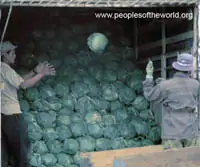 All other aspects of Koho socio-economic and socio-political
life are determined by the males of the community. (Even in a marriage proposal, the maternal
uncle, if there is one, must agree to the union before it is approved.)
A village headman is
elected to oversee village affairs and local government relations. He also presides over issues
dealing with the allocation of land and crops. This organizational structure was supported and
encouraged by the early French colonialists as a convenient way to raise taxes from the Koho. That
legacy of French colonial government survives to this day among the Viet.
All other aspects of Koho socio-economic and socio-political
life are determined by the males of the community. (Even in a marriage proposal, the maternal
uncle, if there is one, must agree to the union before it is approved.)
A village headman is
elected to oversee village affairs and local government relations. He also presides over issues
dealing with the allocation of land and crops. This organizational structure was supported and
encouraged by the early French colonialists as a convenient way to raise taxes from the Koho. That
legacy of French colonial government survives to this day among the Viet.
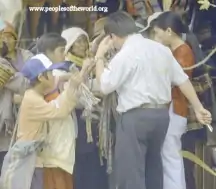 The Koho people's main income is today, as it always has been, derived from farming.
Rice is the Koho's stable food, but
vegetables and fruit such as cabbage, corn, gourd, watermellon and pumkin are also grown.
Much of the Koho's historic farmland has been taken over recently by the Viet.
While most Koho moved to
a sedantary lifestyle last century, some groups practiced slash-and-burn farming methods until it was
recently made illegal by the Vietnamese government. I personlly witnessed (and photographed) incendiary deforestation
in the area of a Koho village in the Central Highlands, but based on accounts from both the local Koho
villagers and local Viet
communities, I was unable to ascertain whether what I saw was planned deforestation, preventative measures
to curtail future forest fires or illegal slash-and-burn
farming.
The Koho people's main income is today, as it always has been, derived from farming.
Rice is the Koho's stable food, but
vegetables and fruit such as cabbage, corn, gourd, watermellon and pumkin are also grown.
Much of the Koho's historic farmland has been taken over recently by the Viet.
While most Koho moved to
a sedantary lifestyle last century, some groups practiced slash-and-burn farming methods until it was
recently made illegal by the Vietnamese government. I personlly witnessed (and photographed) incendiary deforestation
in the area of a Koho village in the Central Highlands, but based on accounts from both the local Koho
villagers and local Viet
communities, I was unable to ascertain whether what I saw was planned deforestation, preventative measures
to curtail future forest fires or illegal slash-and-burn
farming.
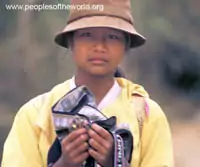 In the Central Highlands today, the Viet outnumber the indigenous peoples collectively by about 3:1.
In the Central Highlands today, the Viet outnumber the indigenous peoples collectively by about 3:1.
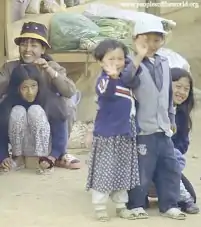 In addition, much of the land is now endangered by projects such as hydroelectric power plants and logging.
This ongoing loss of their traditional source of income has led some Koho, at least in areas visited by outsiders,
to supplement their income by selling their traditional handicrafts such as fabric and
basket weaving.
For some reason that I am unable to explain, however, their other skills such as musical instrument making
(including flutes crafted from bamboo and sacrficed buffalo horns) as well as pottery are rarely to be found
for sale.
In addition, much of the land is now endangered by projects such as hydroelectric power plants and logging.
This ongoing loss of their traditional source of income has led some Koho, at least in areas visited by outsiders,
to supplement their income by selling their traditional handicrafts such as fabric and
basket weaving.
For some reason that I am unable to explain, however, their other skills such as musical instrument making
(including flutes crafted from bamboo and sacrficed buffalo horns) as well as pottery are rarely to be found
for sale.
I found the Koho in Vietnam to be among the most welcoming of any ethnic minority group I have ever visited. I would recommend to anyone visiting Vietnam who has an interest in indigenous cultures to take the time to visit a Koho village.
Photography copyright © 1999 - 2025, Ray Waddington. All rights reserved. Text copyright © 1999 - 2025, The Peoples of the World Foundation. All rights reserved.

Waddington, R. (2002), The Indigenous Koho People. The Peoples of the World Foundation. Retrieved December 27, 2025, from The Peoples of the World Foundation. <https://www.peoplesoftheworld.org/text?people=Koho>
Web Links Care to Help


